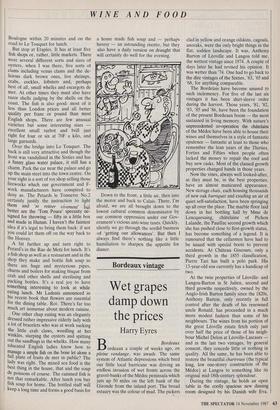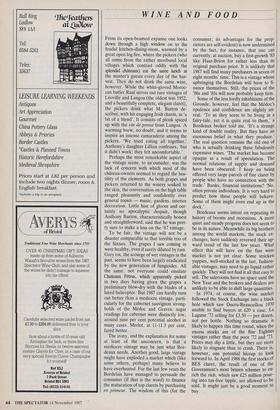Bordeaux vintage
Wet grapes damp down the prices
Harry Eyres
ordeaux a couple of weeks ago, en pleine vendange, was awash. The same system of Atlantic depressions which bred our little local hurricane was driving an endless invasion of wet fronts across the gravel-banks of the Medoc peninsula which juts up 50 miles on the left bank of the Gironde from the inland port. The broad estuary was the colour of mud. The pickers clad in yellow and orange oilskins, cagouls, anoraks, were the only bright things in the flat, sodden landscape. It was, Anthony Barton of Leoville and Langoa told me, the wettest vintage since 1974. A couple of days later he had revised his opinion. It was wetter than '74. One had to go back to the dire vintages of the Sixties, '63, '65 and '68, for anything comparable.
The Bordelais have become unused to such inclemency. For five of the last six vintages it has been shirt-sleeve order during the harvest. Those years, '81, '82, '83, '85 and '86, have been the foundation of the present Bordeaux boom — the most sustained in living memory. With nature's unprecedented co-operation the chatelains of the Medoc have been able to house their wines and themselves in a style of fantastic opulence — fantastic at least to those who remember the lean years of the Thirties, Forties and Fifties when people often lacked the money to repair the roof and buy new casks. Most of the classed growth properties changed hands in those years.
Now the vines, always well looked-after, as they must be, in the best properties, have an almost manicured appearance. New storage chaffs, each housing thousands of new oak barriques and exuding an air of quiet self-satisfaction, have been springing up all over the place. The marble floor laid down in her bottling hall by Mme de Lencquesaing, chatelaine of Pichon Lalande, the Pauillac second growth which she has pushed close to first-growth status, has become something of a legend. It is rumoured that the cellarmen have had to be issued with special boots to prevent accidents. At Chateau Giscours, only a third growth in the 1855 classification, Pierre Tari has built a polo park. His 13-year-old son currently has a handicap of two.
At the twin properties of Leoville- and Langoa-Barton in St Julien, second and third growths respectively, owned by the Anglo-Irish Barton family since the 1820s, Anthony Barton, only recently in full control after the death of his renowned uncle Ronald, has proceeded in a much more modest fashion than some of his neighbours. The wines from his portion of the great Leoville estate fetch only just over half the price of those of his neigh- bour Michel Delon at Leoville-Lascases and in the last two vintages, by general consent, they concede little or nothing in quality. All the same, he has been able to restore the beautiful chartreuse (the typical long, low one-storey construction of the Medoc) at Langoa to something like its original mid-18th-century splendour.
During the vintage, he holds an open table in the coolly spacious new dinning room designed by his Danish wife Eva.
WINE AND FOOD
From its open-beamed expanse one looks down through a high window on to the feudal kitchen-dining-room, warmed by a great open log fire, where the pickers (who all come from the rather moribund local villages which contrast oddly with the splendid chateaux) eat the same lunch as the master's guests every day of the har- vest. They do not drink the same wine, however. While the white-gloved Moroc- can butler Raul serves out rare vintages of Leoville and Langoa (the oldest was 1952, and a beautifully complete, elegant claret), the pickers drink what M. Barton de- scribes, with his engaging Irish charm, as 'a bit of a blend'. It consists of plonk spiced up with the yin de presse from Langoa. A warming brew, no doubt, and it seems to inspire an intense camaraderie among the pickers. 'We tried eating all together,' Anthony's daughter Lillian confesses, tut it didn't work: they felt uncomfortable.'
Perhaps the most remarkable aspect of the vintage scene, to an outsider, was the lack of concern with which most of the château-owners seemed to regard the hos- tility of the elements. As both grapes and pickers returned to the winery soaked to the skin, the conversation on the high table ranged pleasantly and confidently over general topics — music, gardens, interior decoration. Little hint of gloom and cer- tainly no apocalyptic despair, though Anthony Barton, characteristically honest and straightforward, said that he was pret- ty sure to make a loss on the '87 vintage.
To be fair, the vintage will not be a disaster comparable to that terrible trio of the Sixties. The grapes I saw coming in were healthy, even if surely diluted by rain. Grey rot, the scourge of wet vintages in the past, seems to have been largely eradicated by the new generation of fungicides. All the same, not everyone could emulate Chateaux Petrus, which apparently picked in two days having given the grapes a preliminary blow-dry with the blades of a hired helicopter. But 1987 can hardly turn out better than a mediocre vintage, parti- cularly for the cabernet sauvignon strong- holds of the Medoc and Graves: sugar readings for cabernet were distinctly low, around nine per cent potential alcohol in many cases. Merlot, at 11-11.5 per cent, fared better.
The irony, and the explanation for some at least of the unconcern, is that a mediocre vintage may be just what Bor- deaux needs. Another good, large vintage might have exploded a market which (like some others, perhaps) many believe to have overheated. For the last few years the Bordelais have managed to persuade the consumer (if that is the word) to finance the maturation of top clarets by purchasing en primeur. The wisdom of this (for the consumer; its advantages for the prop- rietors are self-evident) is now undermined by the fact, for instance, that one can currently, at auction, buy a first-growth '83 like Haut-Brion for rather less than its original purchase price. It is unlikely that 1987 will find many purchasers in seven or eight months' time. This is a vintage whose upbringing the Bordelais will have to fi- nance themselves. Still, the prices of the '86s and '85s will now probably keep firm.
Some of the less lordly inhabitants of the Gironde, however, feel that the Medoc's opulence and confidence are slightly un- real. 'To us they seem to be living in a fairy-tale, yet it is quite real to them,' a Bordeaux broker told me. 'It's a strange kind of double reality. But they have an enormous belief in what they produce.' The real question remains the old one of who is actually drinking these fabulously. expensive wines. 'The market has become opaque as a result of speculation. The normal relations of supply and demand have been obscured. I keep on being offered very large parcels of fine claret by people who have no connection with the trade.' Banks, financial institutions? 'No, often private individuals. It is very hard to predict how these people will behave. Some of them might even end up in the dock.'
Bordeaux seems intent on repeating its history of booms and recessions. A more quiet and steady progress does not seem to be in its nature. Meanwhile its big brothers among the world markets, the stock ex- changes, have suddenly reversed their up- ward trend of the last few years. What effect this will have on the fine wine market is not yet clear. Some stricken yuppies, well-stocked in the last, fashion- able vintages, may need to go liquid rather quickly. They will not find it all that easy to sell. The salerooms have no space until the New Year and the brokers and dealers are unlikely to be able to shift large quantities. In 1974, of course, the wine market followed the Stock Exchange into a black hole which saw Ducru-Beaucaillou 1970 unable to find buyers at £20 a case, La Lagune '72 selling for £3.50 — per dozen, not per bottle. Nothing so dramatic is likely to happen this time round, when the excess stocks are of the fine Eighties vintages rather than the poor '72 and '73. Prices may dip a little, but they are more likely to stagnate than to crash. There is, however, one potential hiccup to look forward to. In April 1988 the first stocks of BES claret, the result of one of the Government's most brazen schemes to en- rich the rich, which saw £25 million pour- ing into tax-free tipple, are allowed to be sold. It might just be a good moment to buy.











































































 Previous page
Previous page